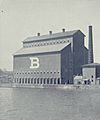Grain elevator facts for kids

A grain elevator is an agrarian facility complex designed to stockpile or store grain. In grain trade, the term grain elevator also describes a tower containing a bucket elevator or a pneumatic conveyor, which scoops up grain from a lower level and deposits it in a silo or other storage facility.
In most cases, the term grain elevator also describes the entire elevator complex, including receiving and testing offices, weighbridges, and storage facilities. It may also mean organizations that operate or control several individual elevators, in different locations. In Australia the term grain elevator describes only the lifting mechanism.
Before the advent of the grain elevator, grain was usually handled in bags rather than in bulk (large quantities of loose grain). Dart's Elevator was a major innovation. It was invented by Joseph Dart, a merchant, and Robert Dunbar, an engineer, in 1842 and 1843, in Buffalo, New York. Using the steam-powered flour mills of Oliver Evans as their model, they invented the marine leg, which scooped loose grain out of the hulls of ships and elevated it to the top of a marine tower.
Early grain elevators and bins were often built of framed or cribbed wood, and were prone to fire. Grain-elevator bins, tanks, and silos are now usually made of steel or reinforced concrete. Bucket elevators are used to lift grain to a distributor or consignor, from which it falls through spouts and/or conveyors and into one or more bins, silos, or tanks in a facility. When desired, silos, bins, and tanks are emptied by gravity flow, sweep augers, and conveyors. As grain is emptied from bins, tanks, and silos it is conveyed, blended, and weighted into trucks, railroad cars, or barges, and shipped to grain wholesalers, exporters, and/or local end-users, such as flour mills, breweries, and ethanol and alcohol distilleries.
Images for kids
-
Saskatchewan Wheat Pool No. 7, Thunder Bay, Ontario
-
Typical "wood-cribbed" design for grain elevators throughout Western Canada, a common design used from the early 1900s to mid-1980s: The former Ogilvie Flour Mill elevator in Wrentham, Alberta, was built in 1925.
-
Silos connected to a grain elevator on a farm in Israel
-
Corrugated-steel grain bins and cable-guyed grain elevator at a grain elevator in Hemingway, South Carolina
-
Old wooden cribbed grain elevator and livestock feedmill in Estherville, Iowa
-
These houses in Halifax, Nova Scotia were constructed in the 1990s long after the elevator had been constructed and are valuable due to their location. In the summer of 2003, an explosion at this elevator sparked a fire that took seven hours to extinguish.
-
Jump-formed concrete annex silos on the left and slip-formed concrete mainhouse at an elevator facility in Edon, Ohio
-
General Mills grain-distribution facility detail, Idaho Falls, Idaho
-
Home Grain Co. wooden cribbed elevator at the Ukrainian Cultural Heritage Village in Alberta
-
Alberta Wheat Pool elevator Ltd. wooden cribbed elevator at the Scandia Eastern Irrigation District Museum in Scandia, Alberta
-
Inglis elevator row, Inglis, Manitoba
-
Ranchway Feeds mill and elevator, Fort Collins, Colorado
-
Circle B grain elevator, Concordia, Kansas
-
Historic Cooperative Elevator, a row of corrugated steel hopper bottom bins on the left and cribbed annex bins on the right, Crowell, Texas
-
Reading Company Grain Elevator near Center City, Philadelphia, now converted into offices
-
Charles Demuth: My Egypt (1927)
See also
 In Spanish: Elevador de granos para niños
In Spanish: Elevador de granos para niños























